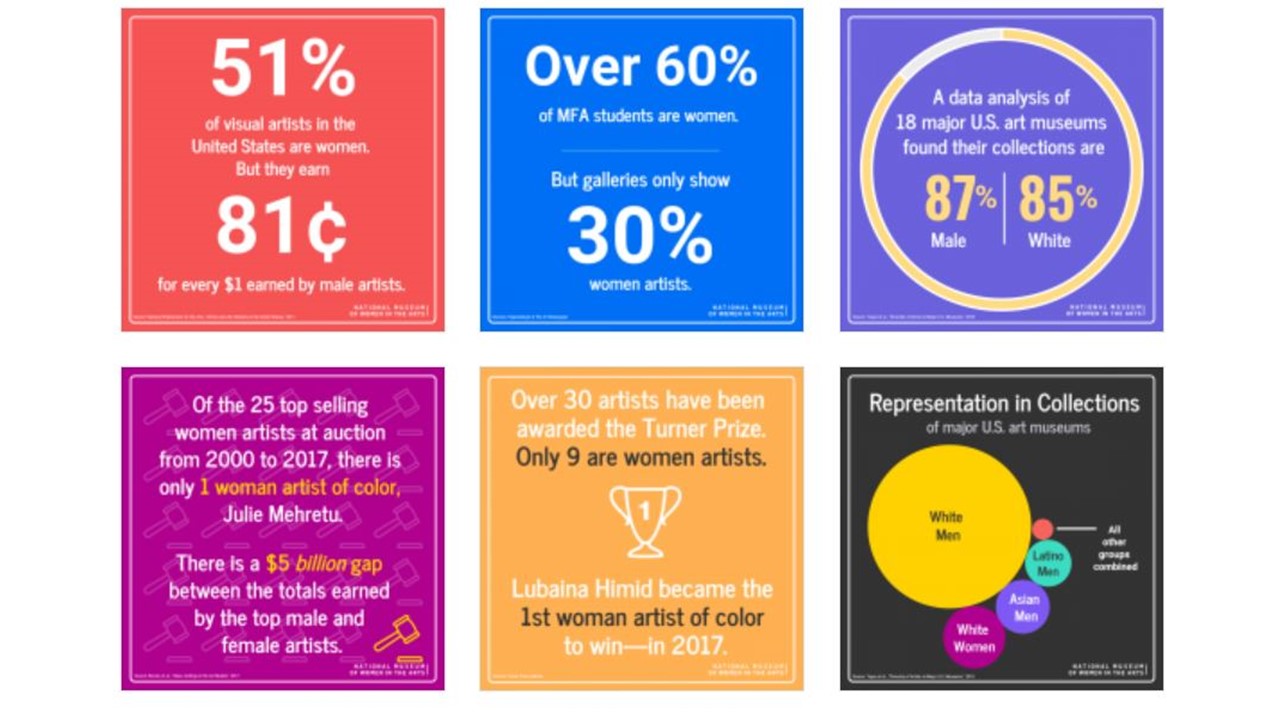
Recently, I’ve been speaking of museums as banks—repositories of enormous wealth of reputation, knowledge, and influence, in addition to the sheer value of their endowments. I’ve advanced the thesis that by managing this wealth as a type of universal basic asset, museums can help individuals and communities build their own private wealth in ways that can redress historic inequities.
Today I am sharing a very specific proposal for how museums can use their collections to balance the profound inequities of wealth and opportunity faced by women artists and artists of color, which stem, in part, from how they have been systematically marginalized in museum collections.
Museums influence the market. When a museum buys or exhibits a work by an emerging artist, it boosts that artist’s reputation, and the sale price of their work as well. This is why savvy collectors follow museum exhibition schedules to inform their investment in art. So far, museums have largely focused on ensuring that people don’t profit from this influence. (Did a collector loan an object in the expectation that the sale price would increase? Was the collector also a donor to the museum, and did he or she use that influence to get their loan into an exhibition?) That concern is valid. Historically, museums have amplified the wealth and power of the already wealthy and powerful cadre of museum founders, donors, and supporters. Even when these benefits don’t cross the line into outright malfeasance, they can, at best, reaffirm the status quo.
Why not spend at least as much mental energy thinking about how people CAN profit from that influence, in a way that promotes economic equity and addresses historic exclusion?
My proposal: create a conscious plan of collections acquisition, exhibition, and eventual sale designed to boost the reputation and earnings of artists traditionally overlooked by our field. Here’s how it could work: A museum purchases twenty contemporary works by artists who are women or people of color. For the next decade the museum exhibits these works, loans them to other institutions, and includes them in catalogs. They invite the artists to give talks, fete them at openings and introduce them to donors and collectors. At the end of that decade, they sell these works and use the proceeds to buy the next cohort of work, and so on.
I’m betting that through these actions the museum will have a measurable effect on the reputation and earnings of the artists whose work they acquire. The museum has, in effect, used its tangible assets (funds for collections, exhibition space, publications) and intangible assets (reputation, reach, influence) as public assets in the service of artists who have been historically excluded or disadvantaged by the art market.
Some variations on this theme:
- Generate the funds to purchase the initial cohort of work by deaccessioning and selling works by white, male artists who are, overall, overrepresented in museum collections. This practice is already being pioneered by the Baltimore Museum of Art, which last year sold seven works by famous (white, male) artists, yielding over $7.5M which it then used to purchase works by Amy Sherald, Wangechi Mutu, Lynette Yiadom-Boakye, and others.
- Sell most of the works from any given cohort, but keep a few, helping shift the museum’s own collections towards an equitable representation of artists by gender and race. Sub-variation: invite the community to vote on which works from the cohort the museum will keep. (Taking a page from the Nelson-Atkins Museum of Art, which in 2011 let the public decide which sculptures from an exhibit by Roxy Paine Scumak to add to the permanent collection.)
- Give preference to other museums when the works are sold, so that this art remains in the public domain
- Sell the works in a way to maximize their sale value, adding to the reputation and earning power of the artists
- Commit to sharing part of the increased value of the work, as realized at sale, with the artist themselves. (Sub-variation on the theme, register the work on the blockchain, with an embedded smart contract that ensures that every time the work changes owners in the future, a portion of the sale price is transferred to the artist. To untangle what THAT means, read the Blockchain chapter from TrendsWatch 2019.)
So—to coopt a current meme:
Museums can use their power to build the careers and earning power of artists historically ignored by the establishment. Change my mind.








